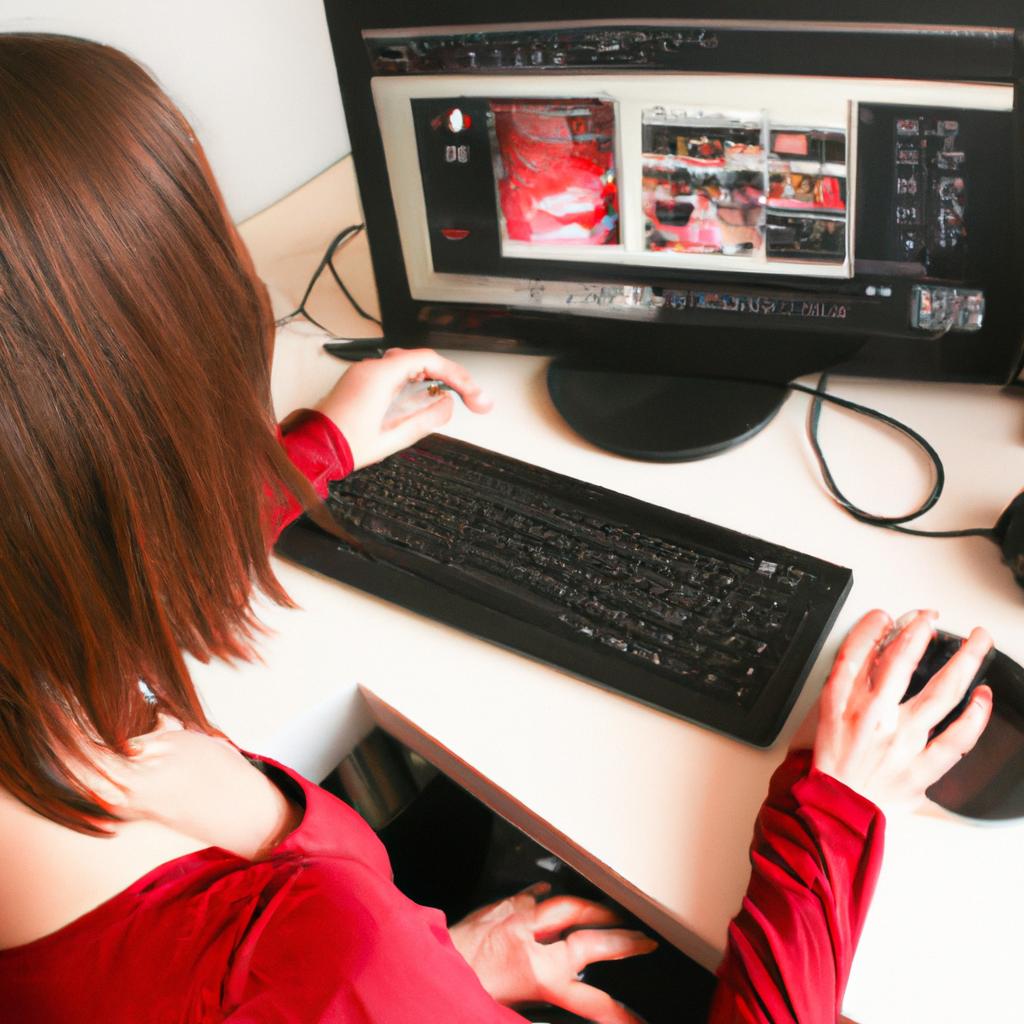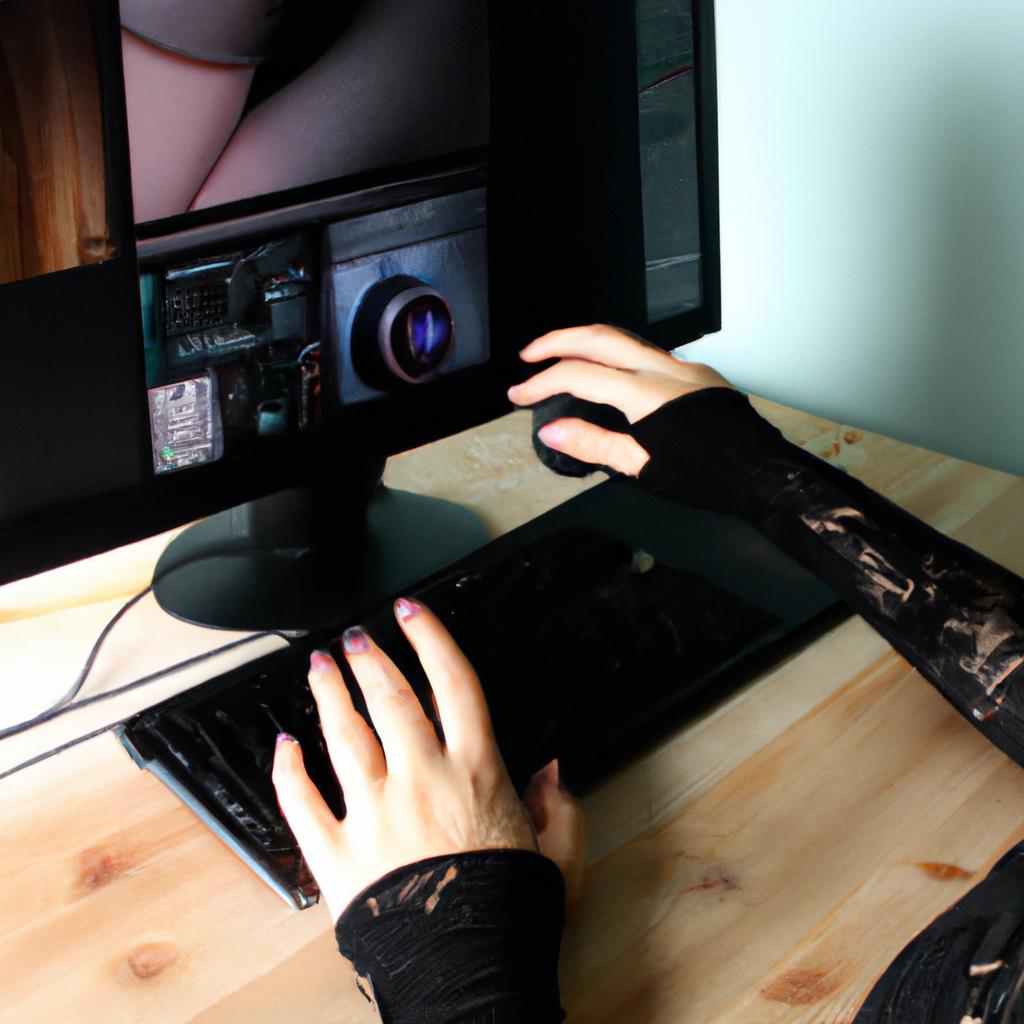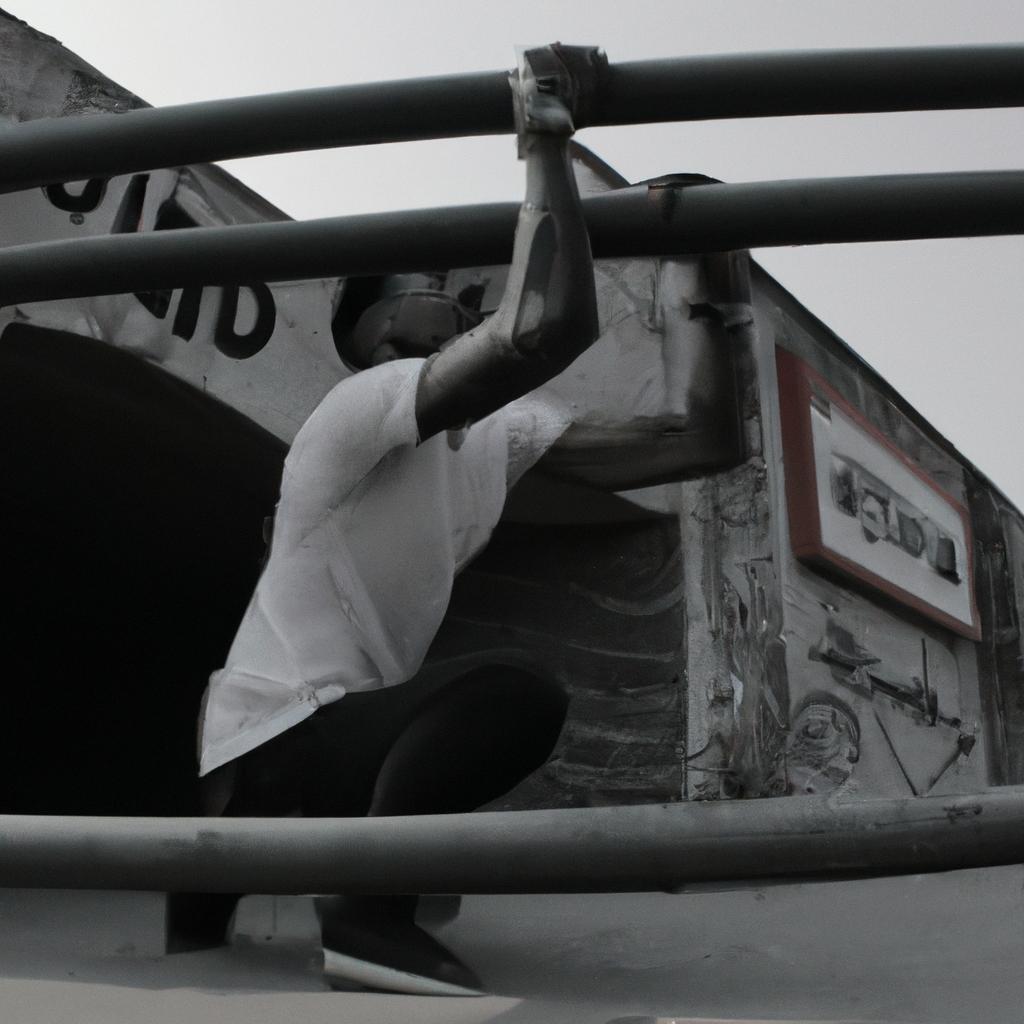The world of photography has gone through various transformations over the years, with different styles and techniques emerging to capture unique moments and evoke specific emotions. One such style that has gained popularity in recent times is boudoir photography. Boudoir photography focuses on capturing intimate and sensual images of individuals, typically women, in a private setting. This genre allows photographers to explore their creativity by experimenting with editing styles that can enhance the overall aesthetic appeal of the photographs.
To illustrate this point, let us consider a hypothetical case study. Imagine a skilled boudoir photographer who wishes to create a vintage-inspired photo series for her client. She carefully selects soft lighting, elegant props, and classic wardrobe pieces reminiscent of the 1950s era. However, it is during post-processing where she truly brings this vision to life. By applying various editing techniques such as desaturation, adding grain, and adjusting tones to achieve warm sepia or cool blue undertones, she successfully transforms these modern-day images into timeless masterpieces imbued with nostalgia.
This article aims to delve deeper into the concept of editing styles within the realm of boudoir photography, specifically focusing on the growing trend of incorporating vintage elements into contemporary images. By exploring various editing methods used by photographers today, readers will gain a better understanding of how post-processing can be used to enhance the overall aesthetic and evoke specific emotions in boudoir photography. Additionally, this article will provide insights into the technical aspects of editing, including software recommendations and step-by-step tutorials for achieving vintage-inspired looks. Whether you are a photographer looking to expand your editing repertoire or an enthusiast seeking to appreciate the artistry behind boudoir photography, this article will serve as a valuable resource for exploring the world of editing styles in this genre.
The Rise of Vintage Aesthetics
Boudoir photography has evolved over time, with editing styles playing a significant role in shaping its visual appeal. One prominent trend that has gained popularity is the use of vintage aesthetics. This section explores the rise of vintage editing styles in boudoir photography and their impact on the genre.
To illustrate this phenomenon, let us consider a hypothetical scenario: a professional photographer specializing in boudoir shoots decides to experiment with different editing techniques for her latest project. After completing the photo session, she selects a set of images featuring soft pastel tones, faded highlights, and subtle film grain effects. These edits lend an air of nostalgia and evoke emotions reminiscent of classic pin-up photographs from the 1950s. Intrigued by the results, our photographer decides to incorporate more vintage elements into her future projects, thus embarking on her journey through the world of vintage aesthetics.
The growing fascination with vintage aesthetics can be attributed to several factors:
- Nostalgia: By using retro-inspired editing techniques such as sepia tones or aged textures, photographers create images that transport viewers back in time. Nostalgic sentiments often resonate deeply within individuals, evoking feelings of longing and sentimentality.
- Artistic Expression: Vintage editing offers photographers a chance to explore creative possibilities beyond traditional approaches. It allows them to infuse their work with a unique charm and personality that stands out among contemporary trends.
- Empowerment: For many clients seeking boudoir photography services, vintage aesthetics provide an empowering experience. Embracing retro-inspired looks helps individuals tap into their own sense of confidence while celebrating timeless beauty ideals.
- Storytelling: Vintage aesthetics have storytelling capabilities ingrained within them. Through carefully chosen edits, photographers can weave narratives around themes like romance, glamour, and femininity.
To further understand the significance of these developments in boudoir photography editing styles, we can examine the following table:
| Aspects of Vintage Editing | Emotional Response |
|---|---|
| Soft pastel tones | Serenity |
| Faded highlights | Nostalgia |
| Subtle film grain effects | Authenticity |
| Sepia tones | Warmth |
By incorporating vintage aesthetics, photographers aim to evoke emotions such as serenity, nostalgia, authenticity, and warmth in their viewers. These emotional responses contribute to a richer experience that transcends mere visual appreciation.
Understanding the evolution of editing styles in boudoir photography allows us to appreciate both the technical aspects and artistic choices made by photographers. In the subsequent section, we delve deeper into this topic by exploring how editing techniques have evolved over time and adapted to changing societal norms and preferences.
Understanding the Evolution of Editing in Boudoir Photography
Vintage Revolution: Exploring Editing Styles in Boudoir Photography
The Rise of Vintage Aesthetics has sparked a significant shift in the world of boudoir photography, as photographers and clients alike embrace the charm and nostalgia that vintage editing styles can bring to their images. This section delves deeper into the evolution of editing techniques used in boudoir photography, highlighting how vintage aesthetics have become an integral part of the genre.
One compelling example is the case study of photographer Sarah Thompson, who specializes in capturing intimate moments through her lens. By incorporating vintage-inspired editing techniques into her work, she creates a timeless feel that resonates with her clients’ desire for a unique and romantic experience. Sarah’s portfolio showcases various aspects of boudoir photography, ranging from soft pastels reminiscent of old film cameras to rich black-and-white tones that evoke classic Hollywood glamour.
To better understand the impact of vintage aesthetics on boudoir photography, let us explore some key reasons why these editing styles resonate so deeply:
- Nostalgia: Vintage aesthetics tap into our longing for simpler times and evoke feelings of nostalgia and sentimentality.
- Timelessness: The use of vintage filters can give photographs a timeless quality, making them appear as if they could belong to any era.
- Intimacy: Softening colors and adding grain or vignettes can create an intimate atmosphere, enhancing the emotional connection between subject and viewer.
- Individuality: Vintage editing allows photographers to infuse their own artistic touch while still maintaining a cohesive aesthetic.
Table 1:
| Reasons Why Vintage Aesthetics Resonate |
|---|
| Nostalgia |
| Timelessness |
| Intimacy |
| Individuality |
As we continue our exploration into editing styles in boudoir photography, it becomes evident that these vintage-inspired techniques hold immense appeal for both photographers and clients. In the subsequent section, we will delve further into the impact of film-inspired filters on the genre, examining how they add a unique touch to boudoir images.
Transitioning smoothly into our next topic, Exploring the Impact of Film-Inspired Filters, we will delve deeper into the allure and influence these editing techniques have had on contemporary boudoir photography.
Exploring the Impact of Film-Inspired Filters
As the boudoir photography industry has embraced digital editing tools, many photographers have also found themselves yearning for a return to the artistry and authenticity of hand-editing techniques. While advancements in technology have undoubtedly revolutionized the way images are processed, there is an undeniable charm and character that can be achieved through traditional methods.
Consider the case of photographer Emma Thompson, who specializes in vintage-inspired boudoir photography. Emma recently experimented with recreating the look and feel of classic film prints by meticulously hand-editing her digital images. By carefully adjusting tones and colors using various brushes and filters, she was able to transport her clients back in time, evoking a sense of nostalgia that cannot be replicated by simply applying pre-made presets.
To better understand why some photographers are drawn to these manual editing processes, let us explore their unique appeal:
-
Artistic Expression: Hand-editing allows photographers to fully express their creativity and personal style. Through deliberate brush strokes and nuanced adjustments, they can add depth, texture, or even imperfections that enhance the overall aesthetic value of an image.
-
Uniqueness: Each photograph becomes truly one-of-a-kind when edited by hand. Photographers have full control over every element within the frame, resulting in a final product that stands apart from mass-produced edits commonly seen today.
-
Intimate Connection: The process of manually editing photographs creates a deeper connection between the artist and their work. Every adjustment made is purposeful and intentional; each stroke represents countless hours spent perfecting an image.
-
Timelessness: When executed skillfully, hand-edited images possess a timeless quality that transcends trends or passing fads. This enduring allure resonates with viewers on a subconscious level, eliciting emotions tied to cherished memories or long-forgotten eras.
By embracing these traditional practices alongside modern digital techniques, boudoir photographers are able to offer their clients a diverse range of editing styles.
[Embracing the Minimalist Approach]: Boudoir photography goes back to its essence by stripping away unnecessary elements.Embracing the Minimalist Approach
Having examined the impact of film-inspired filters on boudoir photography, we now turn our attention to another editing style that has gained popularity in recent years – embracing the minimalist approach. By stripping away unnecessary elements and focusing on simplicity, this editing style allows photographers to create images that exude elegance and timelessness.
To illustrate the power of minimalism in boudoir photography, let us consider a hypothetical case study. A photographer is capturing an intimate moment between a couple during a boudoir session. Instead of filling the frame with elaborate props or busy backgrounds, they choose to focus solely on the connection between the subjects. With careful composition and lighting techniques, they capture an image that speaks volumes about love and intimacy without any distractions.
This deliberate choice to embrace minimalism in boudoir photography can evoke various emotional responses from viewers. Here are some key aspects that contribute to its effectiveness:
- Simplicity: The absence of clutter and excessive details allows viewers to direct their attention towards the subject matter itself.
- Elegance: Minimalist edits often give images a refined and sophisticated aesthetic, enhancing their overall visual appeal.
- Intimacy: By removing unnecessary distractions, minimalism creates a sense of closeness and vulnerability within the photograph.
- Timelessness: The clean lines and uncluttered compositions lend themselves well to creating images that stand the test of time.
| Aspects | Emotional Response |
|---|---|
| Simplicity | Focus and clarity |
| Elegance | Sophistication |
| Intimacy | Vulnerability |
| Timelessness | Longevity |
Incorporating these principles into one’s editing process can elevate boudoir photographs to new heights. By consciously choosing simplicity over complexity, photographers have the opportunity to create timeless pieces that resonate with viewers on a deep emotional level. Transitioning into the subsequent section about “Experimenting with High-Contrast Edits,” photographers can further explore how contrasting editing styles can evoke different moods and enhance visual storytelling without adhering strictly to minimalist principles.
Experimenting with High-Contrast Edits
The minimalist approach in boudoir photography has gained popularity for its simplicity and clean aesthetic. However, there is another editing style that offers a unique charm and timeless appeal – vintage edits. By adding nostalgic tones, soft fades, and film-like grain to photographs, photographers can transport viewers back in time while capturing the beauty of the present moment.
For instance, imagine a boudoir photograph depicting a bride getting ready for her wedding day. Through skillful vintage editing techniques, such as sepia toning and vignetting, the photographer enhances the romantic atmosphere surrounding this significant event. The muted colors and dreamy textures evoke emotions of nostalgia and sentimentality, connecting viewers with their own memories or longings for bygone eras.
To achieve captivating vintage edits in boudoir photography, photographers employ various methods:
- Tonal adjustments: Manipulating color channels allows for recreating specific vintage looks like warm orange hues reminiscent of old film stock.
- Grain overlays: Applying subtle noise or grain overlays replicates the texture found in traditional film photography, further enhancing the vintage feel.
- Softening effects: Gentle blurring or diffusion filters create a hazy look that emulates older photographic processes.
- Distressed borders: Adding distressed edges or simulated scratches around the frame gives images an authentic aged appearance.
In addition to these techniques, it is worth considering how different poses, lighting setups, and wardrobe choices can complement vintage edits. A carefully selected combination can enhance the overall effect and strengthen the narrative behind each photograph.
By exploring vintage editing styles in boudoir photography, artists have an opportunity to add depth and character to their work. These evocative aesthetics not only captivate viewers but also foster emotional connections through shared experiences or desires rooted in our collective pasts. In the following section about “Balancing Color Grading Techniques,” we will delve into another aspect of post-processing that allows photographers to further enhance their creative vision without compromising the nostalgic charm of vintage edits.
Balancing Color Grading Techniques
Exploring the Art of Vintage Editing in Boudoir Photography
Having delved into the realm of high-contrast edits, let us now turn our attention towards another captivating editing style known as vintage. This distinct approach to post-processing has gained popularity among boudoir photographers for its ability to evoke a sense of nostalgia and timeless beauty. By infusing images with faded tones, film grain, and soft vignettes, vintage editing transports viewers back to an era filled with elegance and sophistication.
To illustrate the impact of vintage editing, consider a hypothetical case study featuring a boudoir photograph captured in black and white. The original image showcases a model adorned in delicate lace lingerie against a classic backdrop. When applying the vintage editing technique, subtle sepia tones are added to mimic the warm hues associated with aged photographs. Additionally, carefully placed film grain enhances texture while providing an authentic touch reminiscent of traditional film photography. Finally, a gentle vignette draws focus towards the subject’s radiant expression, intensifying her allure within the frame.
When incorporating vintage editing styles into your own boudoir photography practice, keep in mind these key considerations:
- Subject matter: Vintage editing often works best when paired with subjects or settings that exude old-world charm or possess elements from bygone eras.
- Color palette: Selecting muted or desaturated colors can enhance the overall vintage aesthetic, reinforcing the nostalgic atmosphere.
- Texture enhancement: Carefully applied film grain and textures add depth and character to images, recreating the look and feel of analog photography.
- Vignetting: Subtle or pronounced vignetting can draw attention to specific areas within an image while contributing to its vintage appeal.
By embracing these techniques alongside others unique to your individual vision as a boudoir photographer, you have the opportunity to transport clients into an enchanting world where time seems suspended. Through deliberate choices in color grading methods such as high contrast edits discussed earlier and the vintage approach explored in this section, you can create captivating imagery that resonates deeply with viewers. Remember to experiment, adapt, and refine your editing style as you continue on your journey of artistic expression within boudoir photography.
 LW Larsen Photo
LW Larsen Photo



